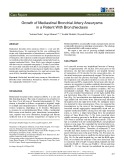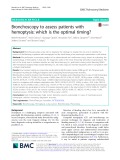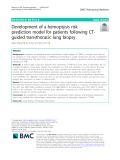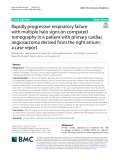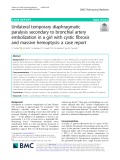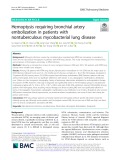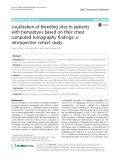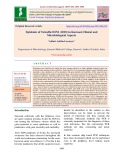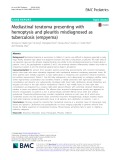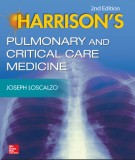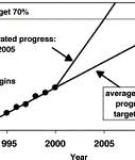
Hemoptysis patients
-
Mediastinal bronchial artery aneurysm (BAA) is a rare and lifethreatening disease. We experienced the first case confirming that, despite only slight deterioration of bronchiectasis, mediastinal BAAs expanded remarkably. A 61-year-old female was hospitalized because of hemoptysis. Her respiratory condition required intubated mechanical ventilation.
 4p
4p  viintuit
viintuit
 26-09-2023
26-09-2023
 1
1
 0
0
 Download
Download
-
Bronchoscopy plays a key role to diagnose the etiology, to localize the site, and to identify the sources of the bleeding in patients with hemoptysis, but the ideal timing of an endoscopic examination is still unclear.
 6p
6p  vimontana2711
vimontana2711
 05-04-2021
05-04-2021
 13
13
 3
3
 Download
Download
-
Multidetector computed tomography (MDCT) angiography is a useful examination to detect the source of the bleeding in patients with hemoptysis. The aim of the study was to prospectively evaluate the role and clinical efficacy of MDCT angiography before bronchial artery embolization (BAE) for the management of hemoptysis, and to investigate the predictors of early recurrence.
 10p
10p  vimichigan2711
vimichigan2711
 26-03-2021
26-03-2021
 13
13
 1
1
 Download
Download
-
Computed tomography-guided transthoracic needle biopsy (CT-TNB) is a widely used method for diagnosis of lung diseases; however, CT-TNB-induced bleeding is usually unexpected and this complication can be life-threatening. The aim of this study was to develop and validate a predictive model for hemoptysis following CT-TNB.
 10p
10p  vimichigan2711
vimichigan2711
 26-03-2021
26-03-2021
 7
7
 1
1
 Download
Download
-
Primary cardiac neoplasms are extremely rare, with an autopsy incidence of 0.0001–0.003%. Primary cardiac sarcoma is usually derived from the right atrium and it manifests as chest pain, arrhythmia, hemoptysis, dyspnea, and fatigue. The most common target organ for metastasis of primary angiosarcoma is the lungs, but the radiological-pathological correlation has been rarely reported.
 6p
6p  vimichigan2711
vimichigan2711
 26-03-2021
26-03-2021
 13
13
 2
2
 Download
Download
-
Massive hemoptysis is a serious complication in Cystic Fibrosis (CF), occurring commonly in older patients. Bronchial artery embolization (BAE) can be performed to stop the bleeding. BAE is generally safe and effective, but can sometimes lead to serious complications.
 3p
3p  vimaine2711
vimaine2711
 26-03-2021
26-03-2021
 10
10
 2
2
 Download
Download
-
Although infections caused by nontuberculous mycobacteria (NTM) are increasing in prevalence, there are few data about hemoptysis in patients with NTM lung disease. This study investigated the characteristics and prognosis of hemoptysis secondary to NTM infection.
 7p
7p  vimaine2711
vimaine2711
 26-03-2021
26-03-2021
 6
6
 1
1
 Download
Download
-
The aim of this study was to propose a localization strategy for bleeding sites in hemoptysis patients using their chest computed tomography (CT) findings. The localization of bleeding sites in hemoptysis patients could be determined by chest CT findings such as the most prominent GGA, malignancy and fungus ball.
 6p
6p  vimaine2711
vimaine2711
 26-03-2021
26-03-2021
 6
6
 2
2
 Download
Download
-
Respiratory tract infections are among the most common infections in India. Multiple etiological agents are involved in the causation of these infections. Swine flu H1N1 is one among the influenza viruses which has great potential to cause epidemics as well as pandemics with great mortality and morbidity. All the suspected cases should be identified at the earliest so that interventions can be taken to prevent the spread of infections and thus contain the outbreaks.
 6p
6p  caygaocaolon3
caygaocaolon3
 27-02-2020
27-02-2020
 10
10
 1
1
 Download
Download
-
Mediastinal teratoma presenting with hemoptysis and pleuritis misdiagnosed as tuberculosis (empyema)
The main rarity of our reported cases was the dynamic imaging findings very similar to the developmental process of tuberculosis in patients 1 and 2, the pachypleuritis in patients 2 and 3, the extremely elevated inflammatory markers very similar to empyema in patient 3, and the extremely atypical tumor shape in all patients.
 6p
6p  vidublin2711
vidublin2711
 13-01-2020
13-01-2020
 17
17
 1
1
 Download
Download
-
A 44-year-old man who had suffered from chest pain and persistent hemoptysis for about 2 months before being admitted to 103 Mliltary Hospital. During hospitalization, he developed symptoms of nervous injuries (disturbance of consciousness and right-sided paralysis) as well as imaging of a tumor in the left lateral ventricle on megnetic resonance imaging.
 5p
5p  viathena2711
viathena2711
 10-10-2019
10-10-2019
 8
8
 1
1
 Download
Download
-
(BQ) Part 1 of the document Harrison's pulmonary and critical care medicine presents the following contents: Diagnosis of respiratory disorders, diseases of the respiratory system, general approach to the critically ill patient.
 287p
287p  thangnamvoiva2
thangnamvoiva2
 25-06-2016
25-06-2016
 53
53
 3
3
 Download
Download
-
The indications for these surgical procedures were: recurrent hemoptysis (24 cases), massive hemoptysis (4 cases), multi drug resistant TB (4 cases), bronchiectasis and recurrent infection (2 cases), and right bronchial stenosis (1 case). In two of the patients the indication for surgery was intra-bronchial carcinoid tumour. Lymph node biopsies obtained during the surgery showed pathological changes of TB.
 4p
4p  taisaocothedung
taisaocothedung
 12-01-2013
12-01-2013
 38
38
 1
1
 Download
Download
-
In this cross-sectional study data was obtained from reviewing the files of 1,594 patients who underwent bronchoscopy in Afzalipour Hospital during 2003-2007. These patients had various conditions ranging from chronic cough to abnormal findings on chest xray and hemoptysis and all underwent bronchoscopy due to the doctors’ orders. All cases consented to this study. Their bronchoscopy was done by experts who were skillful at diagnosing bronchial anthracosis. Bronchial anthracosis was characterized by dark pigmentations within airway mucosa found during bronchoscopy.
 0p
0p  taisaocothedung
taisaocothedung
 12-01-2013
12-01-2013
 40
40
 1
1
 Download
Download
-
Bronchial Adenomas Bronchial adenomas (80% are central) are slow-growing endobronchial lesions; they represent 50% of all benign pulmonary neoplasms. About 80–90% are carcinoids, 10–15% are adenocystic tumors (or cylindromas), and 2–3% are mucoepidermoid tumors. Adenomas present in patients 15–60 years old (average age 45) as endobronchial lesions and are often symptomatic for several years. Patients may have a chronic cough, recurrent hemoptysis, or obstruction with atelectasis, lobar collapse, or pneumonitis and abscess formation.
 5p
5p  konheokonmummim
konheokonmummim
 03-12-2010
03-12-2010
 236
236
 2
2
 Download
Download
-
Clinical Manifestations Lung cancer gives rise to signs and symptoms caused by local tumor growth, invasion or obstruction of adjacent structures, growth in regional nodes through lymphatic spread, growth in distant metastatic sites after hematogenous dissemination, and remote effects of tumor products (paraneoplastic syndromes) (Chaps. 96 and 97). Although 5–15% of patients with lung cancer are identified while they are asymptomatic, usually as a result of a routine chest radiograph or through the use of screening CT scans, most patients present with some sign or symptom.
 5p
5p  konheokonmummim
konheokonmummim
 03-12-2010
03-12-2010
 65
65
 6
6
 Download
Download
-
Approach to the Patient: Hemoptysis The history is extremely valuable. Hemoptysis that is described as bloodstreaking of mucopurulent or purulent sputum often suggests bronchitis. Chronic production of sputum with a recent change in quantity or appearance favors an acute exacerbation of chronic bronchitis. Fever or chills accompanying bloodstreaked purulent sputum suggests pneumonia, whereas a putrid smell to the sputum raises the possibility of lung abscess. When sputum production has been chronic and copious, the diagnosis of bronchiectasis should be considered.
 7p
7p  ongxaemnumber1
ongxaemnumber1
 29-11-2010
29-11-2010
 69
69
 4
4
 Download
Download
-
Complications Common complications of coughing include chest and abdominal wall soreness, urinary incontinence, and exhaustion. On occasion, paroxysms of coughing may precipitate syncope (cough syncope; Chap. 21), consequent to markedly positive intrathoracic and alveolar pressures, diminished venous return, and decreased cardiac output. Although cough fractures of the ribs may occur in otherwise normal patients, their occurrence should at least raise the possibility of pathologic fractures, which are seen with multiple myeloma, osteoporosis, and osteolytic metastases.
 5p
5p  ongxaemnumber1
ongxaemnumber1
 29-11-2010
29-11-2010
 85
85
 3
3
 Download
Download
-
Harrison's Internal Medicine Chapter 34. Cough and Hemoptysis Cough Cough is an explosive expiration that provides a normal protective mechanism for clearing the tracheobronchial tree of secretions and foreign material. When excessive or bothersome, it is also one of the most common symptoms for which patients seek medical attention. Reasons for this include discomfort from the cough itself, interference with normal lifestyle, and concern for the cause of the cough, especially fear of cancer. Mechanism Coughing may be initiated either voluntarily or reflexively.
 5p
5p  ongxaemnumber1
ongxaemnumber1
 29-11-2010
29-11-2010
 88
88
 7
7
 Download
Download
-
Approach to the Patient: Cough A detailed history frequently provides the most valuable clues for the etiology of the cough. Particularly important questions include: 1. Is the cough acute, subacute, or chronic? 2. At its onset, were there associated symptoms suggestive of a respiratory infection? 3. Is it seasonal or associated with wheezing? 4.
 5p
5p  ongxaemnumber1
ongxaemnumber1
 29-11-2010
29-11-2010
 72
72
 3
3
 Download
Download
CHỦ ĐỀ BẠN MUỐN TÌM








